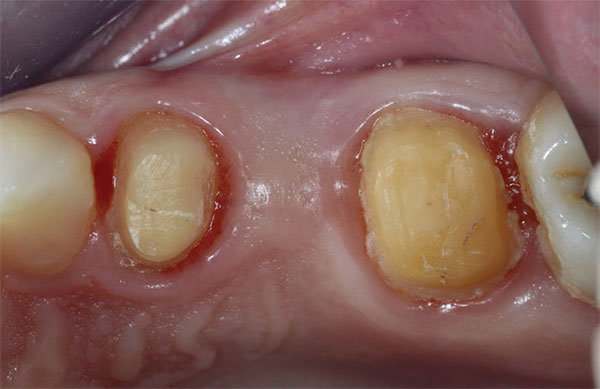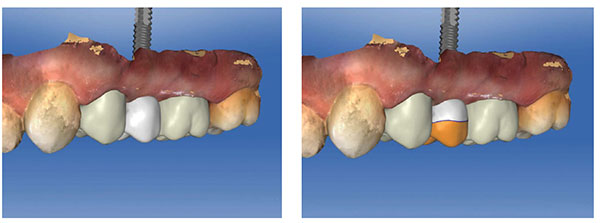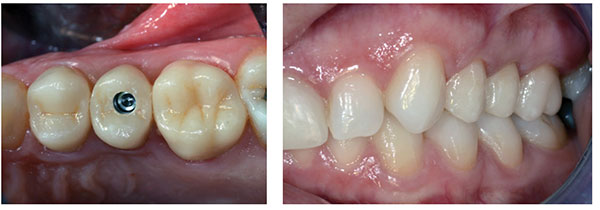Dr. Carlos Repullo Sanchez presents a case where digital techniques were used to place esthetic-fixed bridgework while keeping one eye on future maintenance
A 39-year-old female patient attended the practice reporting that 5 years earlier she had lost her upper right second premolar, which was subsequently restored by means of a three-unit porcelain bridge. Since that time, she had been suffering discomfort due to food retention and difficulty carrying out effective hygiene care at home.
[userloggedin]
Two days prior to her appointment at the practice, the bridge fell off, and she was looking for a new solution. The intraoral examination and X-ray exploration demonstrated there was no decay or periodontal involvement, and the soft tissues looked healthy in form and color. In addition, there was no presence of plaque or tartar, and the occlusion was stable.



Treatment options
Based on the patient’s presentation, it was considered that two possible treatment options could achieve a good outcome:
- A new three-unit fixed porcelain bridge, re-adapting the margins and the pontic in order to avoid food retention and to facilitate hygiene procedures
- A dental implant and a screw-retained crown to replace the UR5 and two single porcelain crowns to restore the UR4 and UR6
The patient was advised that the first restorative option was the best for her in the given circumstances:
- Single crowns allow patients access to the interproximal space for optimal hygiene and maintenance.
- Overloading of the abutment teeth is avoided, which means longevity.
- Dental implants stimulate and preserve bone, helping to prevent bone loss. (Otherwise, free spaces are used for bone resorption.)
- Highly esthetic materials can be used for single crowns (milled lithium disilicate), which are not recommended for three-unit bridges in the posterior area.
The patient agreed to allow three single crowns to be made that would facilitate good interdental access and offer a better gingival contour than previously to help avoid food retention between the teeth.


Treatment plan
The treatment was planned in accordance with the digitally assisted protocol (DAP) technique. This protocol offers optimized dental implant treatment by making full use of in-practice CAD/CAM technology.
It allows the dental professional to perform fully digital dental implant treatment, from planning through restoration, without the need for impressions, plaster models, wax diagnoses, and so on. This means fewer clinical procedures, and therefore, fewer appointments are necessary to complete the treatment, as well as obtaining better esthetic and functional results.
At the first appointment, the implant placement surgery took place. Digital impressions were taken, and provisional crowns (for the UR4 and UR6) and a customized healing abutment (of reduced shape for the UR5) were designed and milled.
The soft tissue contour was molded using a customized healing cup that had the same shape as the final restoration to be placed following the osseointegration period and soft tissue healing, except it was reduced above the gingiva.
This technique allowed the treatment to be completed in just two appointments. Therefore, placement of the final crowns took place at the second appointment; definitive crowns were milled keeping the original design but changing the material.


Soft and hard tissue outcomes
The emergence profile was re-designed, creating a nice contour and a healthy gingiva. The postoperative X-ray confirmed bone stability, which is crucial for the success of the DAP technique.
If there is bone loss, soft tissue outcomes may be compromised, affecting the whole treatment outcome. BioHorizons® implants with Laser-Lok® technology are therefore ideal for the DAP technique due to their ability to maintain bone stability. The patient was very happy with the treatment outcome, from both an esthetic and a functional perspective.
Local discomfort has been eliminated, and the hygiene access is now comparable to that of her natural dentition.
In addition, the new soft tissue contour avoids food retention and helps the restorations to look natural. The patient was also happy about the speed with which the treatment was completed and that only two appointments were needed.
The patient was returned to her general dentist with conventional hygiene procedures recommended; no special care or product recommendations were needed. She was advised to attend a plaque/tartar control appointment within 6 months.

Stay Relevant With Implant Practice US
Join our email list for CE courses and webinars, articles and mores

 Carlos Repullo Sanchez, DDS, graduated from the ISCS-SUL in Lisbon, Portugal. He currently practices implant dentistry in a dental practice in Seville, Spain, and has been doing so for 18 years. He holds a diploma in Implant Dentistry and an Advanced Certificate in Implant Dentistry, both awarded by the Royal College of Surgeons of England. Dr. Sanchez lectures on an international level on CAD/CAM and implant dentistry. He will be speaking about depicting the beauty of nature at the BioHorizons® symposium in London on September 30 titled, “A contemporary renaissance awakening: esthetics in implant dentistry.” The symposium will offer evidence-based information alongside practical guidance.
Carlos Repullo Sanchez, DDS, graduated from the ISCS-SUL in Lisbon, Portugal. He currently practices implant dentistry in a dental practice in Seville, Spain, and has been doing so for 18 years. He holds a diploma in Implant Dentistry and an Advanced Certificate in Implant Dentistry, both awarded by the Royal College of Surgeons of England. Dr. Sanchez lectures on an international level on CAD/CAM and implant dentistry. He will be speaking about depicting the beauty of nature at the BioHorizons® symposium in London on September 30 titled, “A contemporary renaissance awakening: esthetics in implant dentistry.” The symposium will offer evidence-based information alongside practical guidance.

